Do you believe soups are better suited for a specific time of the year? Maybe when it is cold and dreary or rainy outside? For Panamanians, soup is on any day of the week and year. As a matter of fact, you’ll find it on the daily lunch menu at every restaurant or Fonda around the country.
When I was in Austin a few weeks ago, I saw an advertisement for Sopa de Arroz con Pollo (Chicken & Rice Soup). Even though I’ve heard about chicken & rice soup, I never really thought about it in a Latin context until then. Chicken & rice soup doesn’t move me in any way, but Sopa de Arroz con Pollo…? Now, that’s a completely different matter. I simply couldn’t get it off my mind. The possibilities. The potential goodness. Muy rico.
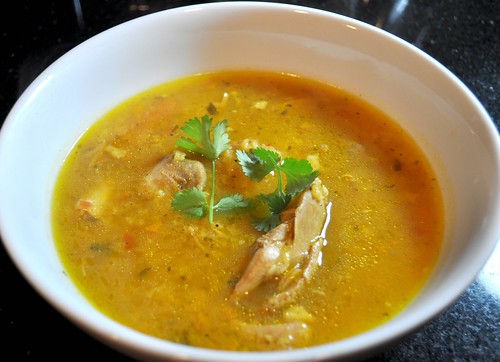
It turned out lighter than I had anticipated, even with the addition of the rice. Rich with the flavors of the chicken broth and culantro. I didn’t have any yuca at home, but next time I make it, I will use that instead of potatoes. And it was a breeze to make too!
Sopa de Arroz con Pollo
1-1/2 lbs of chicken on the bone (I prefer thighs) seasoned with 2 pkts Sazón Goya .
To your blender, add 1/2 onion, 1/2 red bell pepper, 1/4 cp cilantro or 3 culantro leaves and 2 crushed garlic cloves, add just enough water to puree all the ingredients; I ended up with about 3 cps of puree.
Put the seasoned chicken and the puree in a stockpot over medium-high heat and allow it to cook for about 10 minutes, stirring occasionally. This will allow the flavors from the pureed veggies to infuse the chicken before adding all the water for the soup.
After about 10 minutes, add enough water to totally submerge the chicken, about 6 cps, add some chopped potatoes and carrots, season with salt & pepper, and 1 bay leaf. Bring it all to a boil, then lower temperature to allow it to simmer and cook for about 20-30 minutes or until the chicken is tender.
Remove the chicken from the broth and add 1/2 cp of rice to it, allow it cook while the chicken cools enough to remove the bones. Make sure to stir the broth every few minutes, making sure to remove any rice that may stick to the bottom. In the meantime, chop the chicken, if you’d like and return it to the broth. Cook just long enough for the rice to soften.
Serve in bowls and enjoy!
Cookingly yours,
Anamaris
Remember last year when my foodie obsession with Marx Foods began? I remember it like it was just yesterday, aahh that Mangalitsa ham *sigh*. Well, thanks to that very gorgeous piece of ham, I’ve been lucky enough to receive samples of their products as rewards for creating recipes. I’ve gotten so many goodies, it’s madness! The best part is that it allows me to stretch my foodie wings and palate and that makes me a better (and bigger) foodie, cook, aficionada, etc, etc.

Tellicherry Peppercorns from Marx Foods
I submitted recipes for more of their contests, which means I’ve gotten more goodies. I have a box of yummy things in my pantry. Since work has been so hectic, I’ve not had much time to experiment in the kitchen, even less time to share the results with you guys. But I’ve been dying to tell you about a couple of dishes I came up with using some of my loot. This post is not a very good step-by-step one. I blame it on work and exhaustion, that said, these two dishes are way too good not to share with you! Oh.eM.Gee!!! These were sooooo good! I’m drooling just thinking about them.
Keep in mind, many of the spices were gifts from the good
Marx Foods peeps, they are not paying me to say good things about them. What they do want is some honest feedback about their products and hopefully, if all is good, that may generate new customers for them. I know I’m onboard. OK, that’s my little disclaimer, on with the food!
I made two separate dishes for this evening, a Chayote and Mushroom Cream as an appetizer and, for the entrée, Beef Cheeks with Ancho & Guajillo Peppers over White Truffle Rice Cakes. Yeah. Uhuh. Sounds über
good, doesn’t it? I can’t tell you how good they both were, but I’m gonna try.
Let’s start with the soup. You probably know I’m a huge fan of chayote squash, it was one of the few veggies my Mami could get me to eat when I was a kid. As of late, I’ve been using them in a few new-to-me ways, you can find some really good recipes on my blog by doing a ‘chayote’ search. This little vegetable has a very mild taste most similar to a yellow squash IMO.
Chayote and Mushroom Cream
For the soup, I used a variety of dehydrated mushrooms, oyster, porcini and shitake, from Marx Foods. I steeped them in hot water for about an hour, then strained them out and used the reserved liquid to cook the chayotes. I ran the mushroom broth through a coffee filter to catch any grit–though there was none to be found.
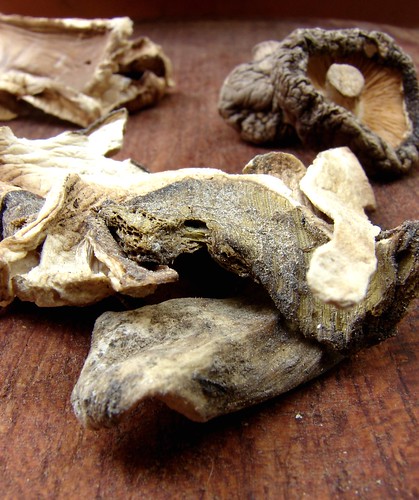
Oyster, Shitake and Porcini Mushrooms
I peeled and cubed 3 chayotes, then cooked them until tender in the mushroom broth (you may need to add a bit more water, just enough to cover the chayotes. The broth was seasoned with Smoked Salt. Once the chayotes are tender, run them through the blender to puree the soup. Return to the pot and add heavy cream, about 1/2 cp or to taste.

Smoked Salt and Tellicherry Peppercorns
While the chayotes cooked, I roughly chopped the mushrooms and sautéed them in 2-3 tbsp of butter. I added 1 tsp ground Tellicherry Peppercorns, more Smoked Salt and about 1/2 cp of dry sherry that was cooked into the mushrooms. Keep warm.
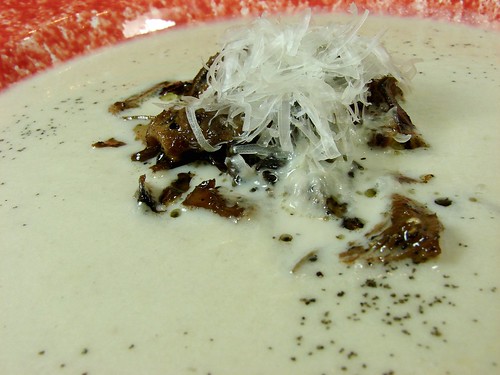
To plate: pour the cream in your bowl, top with a dollop of the sautéed mushrooms, a sprinkling of the Smoked Salt and grated Manchego or Parmesan cheese.
Now, what can I tell you about the entrée…??? I had never cooked beef cheeks before, but I find myself obsessed with them now. I will admit it isn’t one of those things you can make on the fly, because that meat needs to be brought into submission before making it magical. I certainly hope you give it a try, the rewards are indescribable. The meat is melt in your mouth tender and possesses a sweet unctuousness about it.

Ancho & Guajillo Chilies
For this recipe I finished the cheeks with Guajillo & Ancho Peppers and a bit of Fennel Pollen, this gave the final dish a perfect balance of sweet, savory and spiciness that had The Hubbz and I swooning over our plates. The above decadence sat atop rice cakes that had been laced with White Truffle Oil and cream before being crisped in butter.
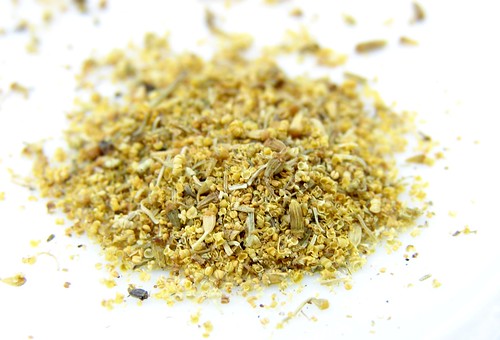
Fennel Polen from Marx Foods
The scent and taste of the Truffle Oil was so rich and intoxicating, it played beautifully against the other ingredients. I then channelled Iron Chef Symon and topped this concoction with a watercress salad that helped cut through this incredibly rich plate. Let’s get to it, shall we?
Beef Cheeks with Ancho & Guajillo Peppers and White Truffle Rice Cakes
To prepare the beef cheeks, I removed any excess fat and tendons early in the day, just before allowing it to braise for an hour or so in water that was seasoned with a couple cloves of garlic (peels and all), bay leaf, salt & pepper. Once tender, cut into cubes, but make sure to reserve the broth produced.
I simmered 2 guajillos and 2 anchos in about 1 cp of the reserved broth, just until they became soft, about 10-15 minutes. If you want to minimize the heat in the dish, remove the seeds before steeping the peppers. I allowed the peppers to cool just enough to handle and chopped them up and added them to a hot pan with about 1tbsp of extra virgin olive oil, followed by 2 tsps of Fennel Pollen, the zest of 1 orange, 1/4 cp of dry sherry, the cubed meat and seasoned with salt & pepper. I added enough of the reserved broth to simmer the beef until it was melt-in-my-mouth tender, about 30-40 minutes.
While the cheeks cooked, I added 1 tbsp of White Truffle Oil and 3 tbsp of heavy cream and 2 tbsp of finely chopped chives to about 2 cps of cooked leftover jasmine rice. I formed the mixture into 4 patties and placed them in the freezer for about an hour to make them easier to handle. Once they were firm on the outside, I ran them through a breading station: flour-egg-panko crumbs. These were then crisped in a skillet in a combo of butter and oil until golden brown.
I made a make-shift vinaigrette for the watercress, by combining the juice of the orange with a bit of Truffle Oil (probably less than 2 tsps), I dressed the watercress with the vinaigrette and a sprinkling of salt & pepper just before serving.

To plate: I placed 2 rice cakes on the plate, topped them with the beef braise and topped that with the watercress salad. Once you make this and take the first bite, you really will think you died and went on to happy orgasmic heaven.
About the Marx Foods ingredients aka The Loot:
Tellicherry Peppercorns: I love these and will be adding them to my pepper mill. Its black peppers on roids! Really big, bold peppery goodness. A must have.
Smoked Salt: I think it is really cool just to look at, but the flavor it adds to your food is surprising. It really makes it taste smoky. Really excited to have my hands on this one.
Dried mushrooms : These were good, but I wasn’t wild about the texture of them, it made me think of seaweed. I still have some left and will try them again, because I think I might’ve not reconstituted them properly. For now, I’m sticking to the fresh stuff.
Dried Guajillo and Ancho Peppers: I simply love these and I’m pretty familiar with them and have them available at almost every grocery store here in town. I did notice that these seemed ‘cleaner’?? Sometimes when I pick them up at the grocers here they look ‘dusty’ and I rinse them before use. The Marx peppers were ready to go.
Fennel Pollen: Yeah, another keeper. This was the second time I incorporated it into a recipe and I absolutely love it!
White Truffle Oil: This baby is sooo good, it should come with its own choir so that you here them chant ‘aaaaaaaaah’ everytime you open the bottle. Gimme, gimme!
There’s more Marx Goodness to come, so stay tuned.
Cookingly yours,
Anamaris

I think I’ve hinted at the fact that Panama is a big seafood country. I may have also shared that we love to party. Overindulgence is quite common to us. When it happens, you hear of various remedies and traditions to cure a persistent hangover. One such remedy: Levanta muerto (raise the dead).
I’m uncertain where the restorative quality of a caldillo de mariscos comes from, or if they are real. What I do know is that it makes for excellent cold weather, hot weather, bad mood, happy mood and comfort food food.

I love seafood soups, but I wanted this broth to be light and filled with the flavors from the sea without being too fishy. So when I went to my fish market, I picked up some mild fish and asked for the carcass to be bagged separately. I then used it to make a deliciously flavored broth.

*To make the broth, I added the fish carcass, shrimp peels (no heads), 1/2 an onion, a few garlic cloves, carrots and celery to a generous pot of water that was seasoned with salt & pepper. I allowed it to simmer for a few minutes, strained and reserved the broth. Here’s how it comes together:
Caldillo de Mariscos (Seafood soup)
Seafood broth*
Clams, scrubbed
Fish (red fish, tilapia or similar), cubed
Shrimp, peeled & deveined
Culantro leaves
Fresh thyme
Yuca, peeled & cubed
Sea salt & pepper
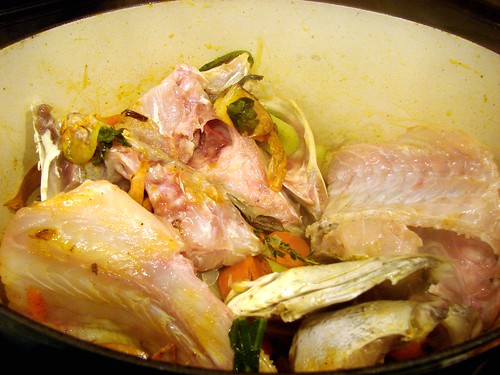
After straining the broth, I returned it to the pot, added the pieces of yuca, chopped culantro leaves (you can substitute with cilantro), a bit of finely chopped thyme, adjust the seasoning as needed. Allow it to cook until the yuca is fork-tender.
While the yuca is cooking, I seasoned the fish and shrimp with 1 tsp of Jugo Maggi (substitute with Worcestershire), then reduced the temperature to bring the broth to a slow simmer and added the fish, shrimp and clams. Allow it to simmer for about 5 minutes, just until the clams open up. Serve with white rice or crusty bread.

Want to see more food porn? Follow this link. Yeah, baby!
Cookingly yours,
Anamaris
Last week Houston enjoyed a healthy dose of real Winter weather (finally!), on Wednesday I was manning a booth for Dress For Success Houston at my neighborhood Whole Foods, the location was appropriate for food thoughts. There I was trying to figure out what to make for dinner, I knew that The Hubbz would enjoy something warm and comforting as much as I would, so a soup of some sort seemed in order. Something creamy, rich, with fish and Panamanian flavor, that’s what I wanted. CHOWDER!

I quickly started jotting things down, instead of clams, fish. No potatoes, let’s use chayote instead. Skip the cream and go for some coconut milk and some salty, fatty pork was mandatory. So I ended up with El Fish Chowder-o. It was delicious, I used some leftover rice to thicken it up a bit and should’ve ran it through the blender, but I got lazy and hungry. Aside: Hubbz, if I had a handy immersion blender I would’ve never skipped this step…, hint, hint. No matter. I took a whisk and made sure all the rice grains were completely obliterated and it was pretty velvety.
You may be wondering what any of this has to do with Iron Chef Morimoto. Well, let me tell you. I know you will have some doubts about this part of the story, but I’ve never lied to you and never will. On day 2 of El Chowder-o, The Hubbz and I were watching Iron Chef Morimoto battle Chef Mehta, the mystery ingredient: Coconut. Morimoto proceeds to work his magic with coconut in every conceivable variation and then it happened. He started making a clam chowder. He cooked a bit of rice in coconut milk and used it as a thickener for the chowder and added more coconut milk to make the broth. Of course my dish styling wasn’t as gorgeous as his, but I had a Morimoto genius moment!

El Fish Chowder-O
1 lb fish (I used some striped bass and salmon), cubed
Salt pork or bacon, diced
2 garlic cloves, crushed
3 culantro leaves or 3 cilantro sprigs
about 6 cps broth
1/2 cp rice, cooked
1 can coconut milk
2 chayotes, peeled & cubed
3 green onions, diced
Salt & black pepper

In medium pot, render the fat from the bacon, add the garlic and cook until soften, add the coconut milk, broth and rice, season with salt and pepper, simmer for about 30 minutes until rice disintegrates. At this point you can run it through the blender to get a smooth broth.
Return to the pot and add the chayote, allowing to cook until fork tender. Once the chayote is cooked, add the fish and 1/2 of the green onions. Simmer for about 10-15 minutes until the fish is cooked and flaky. Add the rest of the green onions and serve with crusty French bread.
Cookingly yours,
Anamaris

This is one of two dishes I prepared to participate in Foodalogue’s Culinary Tour, this time visiting my stomping grounds, Panama! This dish came to be as a result of a ‘What’s in the Bag‘ challenge posed by my dear Hubbz. He went to the store and brought everything but the butcher’s block, which I then had to incorporate into a Latin meal.
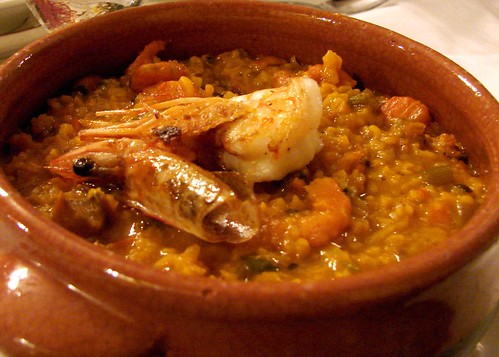
Seafood Guacho at Las Tinajas in Panama
Guacho (pronounced Wah-cho) is a popular Panamanian specialty; a slightly soupy rice dish, similar to an Italian risotto or a Puerto rican asopao. Unlike risotto, guacho is made from regular, long grain white rice that is soaked in water for a bit before it is sautéed and simmered in the cooking liquid of choice. The dish is then flavored and augmented with an array of local ingredients; there’s always some sort of meat or protein from pork, chicken, cured pig’s tails, or seafood, in addition to various beans and roots such as yuca and otoe.
Different from the way I’ve usually explained how to cook rice, the rice in guacho wants for more liquid and a longer cooking time, this allows for the rice starches to develop into a creamy, rich frenzy. I pretty much stuck to the traditional elements of the dish, only straying away in the preparation of the sofrito and by adding mushrooms to the rice itself.
Panamanian sofrito is generally made with onions, bell peppers, tomatoes, garlic and a few other aromatics, this time I included dried chile ancho and guajillos. But enough chatter, let’s cook!

Guacho de Mariscos y Hongos (Seafood & Mushroom Guacho)
6-8 servings
For the guacho:
2 cps long grain rice, soaked
Water
1/2 cp bacon, chopped
Extra virgin olive oil
1 cp mushrooms, diced
1/2 cp shallots, diced
About 8 cps seafood broth
1 cp shrimp, peeled & deveined
1 cp scallops
Sea salt
5 tbsps chile puree
2 cps sofrito
For the sofrito:
2 tbsp extra virgin olive oil
1 cp yellow onions, finely chopped
1 clove garlic, crushed
3 green onion sprigs, finely chopped
3 ripe tomatoes, finely diced
6 tbsps chile puree
Sea salt and a pinch of sugar
In a medium pan heat the oil and add the onions, cook them until soften before adding the garlic and green onions. Then add the tomatoes, 1/2 cp water and chile puree, lower the temperature and allow it to simmer for about 20 minutes. Keep warm.

For the seafood broth: I used the skins from the shrimp, bringing them to a simmer with plenty of water, 1 clove garlic, one of the dry ancho chilies, cilantro (culantro, if you can find it), 1 carrot, salt & pepper. Strain and set aside.
For the chile puree: Rinse and seed the chilies–remember Panamanian food is not typically spicy hot. Put 2 ancho and 1 guajillo chilies in a small pot with 2 cps water, 1 clove garlic, a pinch of salt and simmer for about 10 minutes until the chilies soften. Allow it to cool before running it through the blender. Set aside.
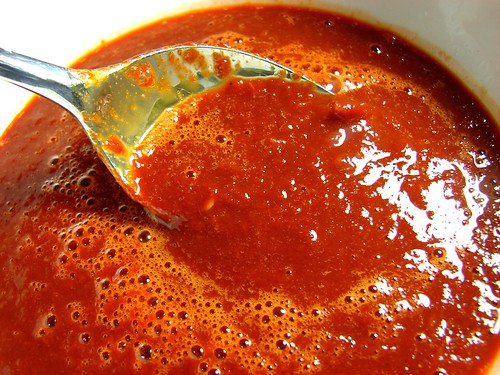
For plating: Reserve a few shrimp and scallops to place over the finished dish.
Preparation – Guacho:
Rinse the rice, then add enough cool water to cover it and allow it to soak for at least 20 minutes and up to 1 hour. In a large pan, render the fat from the bacon, but don’t crisp it. Add the onions and allow to cook until they begin to soften. Then add the mushrooms and cook for about 3 minutes.
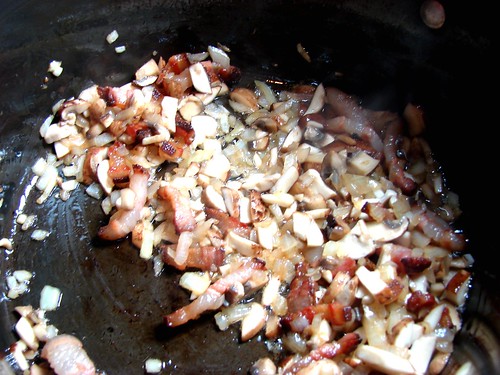
Drain the rice and add to the pan. If necessary, add a bit more olive oil, just enough to coat all the grains. Add 2 tbsps of the chile puree, 6 cps of the seafood broth and adjust the seasoning by adding sea salt as necessary. Lower the temperature to medium-low and allow it to simmer until the broth evaporates. Stir it every so often to make sure nothing gets stuck to the bottom of the pan.

While the rice is cooking, prepare the seafood: chop the shrimp and scallops to bite sizes (remember to save a few of each for plating). Marinate all the seafood (including those for plating) with 2 tbsps of the chile puree and a bit of sea salt and black pepper; set aside until needed.
Once the broth has evaporated, check the doneness of the rice grains. They should be fully open and swollen. If the liquid has evaporated completely, add a bit more broth or water, then add the chopped seafood. Stir in the seafood, bring the temperature to low and allowing to cook covered for another 5 minutes.

In the meantime, saute the reserved shrimp in a bit of olive oil, set aside. When ready to serve, spoon some guacho on the bottom of a bowl, top generously with a couple tbsps of sofrito and top with the sautéed seafood. Enjoy and Buen Provecho!

For the rest of the yummy guacho shots, follow this link. You can also see  the other dish, Langostinos en Caramelo de Maracuyá (Prawns in Passion Fruit Caramel) by following this link. And don’t miss the entries submitted by other food bloggers, visit Foodalogue for the tasty bits.
the other dish, Langostinos en Caramelo de Maracuyá (Prawns in Passion Fruit Caramel) by following this link. And don’t miss the entries submitted by other food bloggers, visit Foodalogue for the tasty bits.
Cookingly yours,
Anamaris
Rumor has it that temperatures are dropping. I have to say this is a rumor, because we, in Houston, must’ve been left off the memo distribution list. I will try not to take it personally, though I’m not sure I’ll be able to keep that promise. Nonetheless, I am here to tell you soup is on the menu.
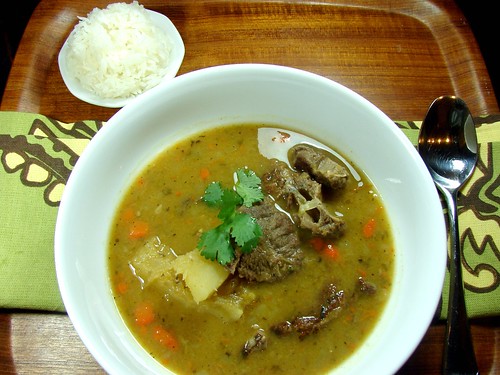
Truth be told, in Panama we have soup any and/or every day of the week. Weather be damned. It’s always hot in my little country, we like soup, we have soup. This one is a favorite of mine. My Gramms used to make it for me when I was little. She would make it various cuts of beef, sometimes with pecho (which comes from the rib area), jarrete (from the shanks), and sometimes with patas (cow’s feet). The constant is the bones. Bones are the best gift you can give soup, they help intensify the flavor of the broth. If they bother you, feel free to remove them after cooking, the meat will literally fall off the bone by the time the soup is done.
This will make a large pot of soup, which is the only way I make soup. I want to have it for a couple of days.
Sopa de Arvejas (Split Pea Soup)
8-10 large servings
1 lb beef shanks, cubed
4 beef short ribs (about 1lb)
Sea salt
Black pepper
2 tsp Italian seasoning
1 serrano or habanero pepper, whole
2 cps dry split peas
2 lbs yuca (about 3 cps), peeled
1 lb otoe (about 1-1/2 cps), peeled
2 medium carrots, chopped
3-4 garlic cloves, chopped
2 bay leaves
1 cp cilantro, leaves and stems
2 cubes beef bouillon
Water
Oil
Beef: Liberally season the short ribs and shanks with Italian seasoning, salt and pepper, set it aside while you get the other ingredients ready.

Split peas: Remove any damaged lentils or debris and rinse in cool water. Add enough water to cover and allow them to soak. Set aside.
Cut the yuca and otoe into pieces about 2-inches long. For the yuca, use a sharp knife, slit the peel off each section. Make sure you slit through the 2nd pinkish layer until you hit the fleshy white meat. At this point, use the sharp edge of the knife and push through the 2nd layer. Rinse and cut into 1-inch pieces. Check out this post for step-by-step instructions.
Carrots-peel and cut into rounds.
For the soup: Heat up a large stockpot and add about 1 tbsp of oil, smear it around. Brown the beef on both sides. Once all the beef is browned, add the drained split peas, 1/2 of the yuca and otoe, all the carrots, the stemmy end of the cilantro, and the bouillon. Fill the pot with water, about 12-15 cps or so.

Allow it to come to a boil, and remove the foam that forms at the top when it boils. Lower the temperature to medium and allow it to come to a strong simmer. Stir it every few minutes, you want to make sure the split peas are not sticking to the bottom of the pan as that would cause the soup to scorch.
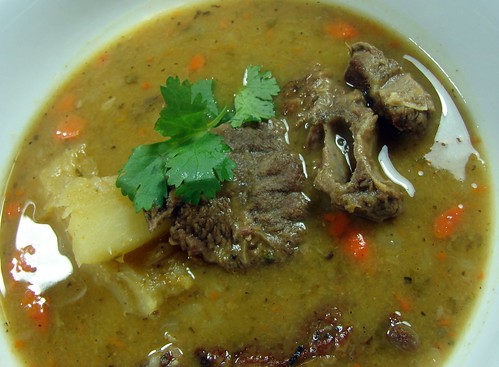
Allow it to simmer slowly for about 1-1/2 hrs for the beef to soften. At that time add the rest of the tubers and cilantro. Check the seasoning and adjust at will. Allow it to cook for another 30 minutes or so. If you used boned short ribs, you can pull those out to remove the bones and cut the meat to bite-size portions.
Serve with white rice If you want to see more soupy shots, follow this link to my photostream.
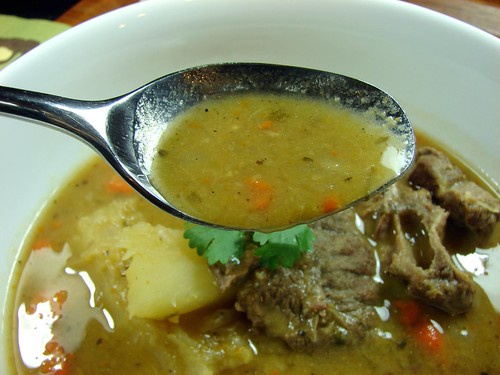
Cookingly yours,
Anamaris
Every meal should have a beginning, a middle and end, just like a good story. The appetizer sets the mood and expectations for what’s to come. Consider it foreplay. You want it to make an impression, to tease but not overshadow.
When I thought about the components for this meal, I knew I wanted to incorporate the ‘traditional’ Thanksgiving ingredients. I also knew I would need to befriend the sweet potato, it’s not one of my favorites. You may recall another post where sweet potato was the star, but dressed in different wardrobe. That’s how I trick myself into liking it.
When I thought about a starter for this meal and considered using sweet potatoes, I wanted to remove most of that barely there sweetness and stay away from the common spices paired with it. The addition of chorizo made this soup even more savory and hearty. This soup is delicious! AND light AND easy. You should definitely try it. You can make the components for the cream ahead of time, then reheat and put it together just before serving.

Sweet Potato Cream with Chorizo
serves 6-8
3-4 medium sweet potatoes
1 bay leaf
2 cloves garlic, peeled
Chicken stock or water
Sea salt
1 tsp cumin
Crema fresca or creme fraiche
For the chorizo:
1 large onion, chopped
1 tbsp extra virgin olive oil
2 tsps balsamic vinegar
1 tbsp sherry or wine
8 ozs Mexican chorizo
Sea salt
Sugar
Black pepper
Peel and chop the potatoes before putting them in a medium saucepan with the stock/water, bay leaf, garlic and salt. Boil and cook until tender. Allow them to cool in the boiling liquid before running through a blender. The sweet potatoes will be very dense, you may need to add additional water in order to puree.
To prepare the chorizo: cook the onions in the oil over medium high heat until softened and the onions begin to turn golden. Add the balsamic vinegar and sherry, cook until it evaporates.
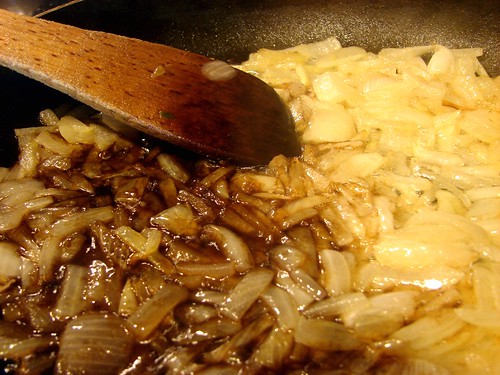
Add the chorizo into the onion mixture, making sure to break it apart so it is a crumble. Chorizo should be thoroughly cooked, but keep the temperature at medium to avoid burning it. Add a couple tablespoons of water and cover with a tight-fitting lid, lower the temperature and allow it to cook for about 10 minutes. Adjust the seasonings as necessary, if you find it to be too tart, add a pinch of sugar. Allow it to cool. Remove the excess fat once it cools down.
To assemble: Pour the hot soup into a bowl, drizzle with cream, then drop a dollop of chorizo in the center.
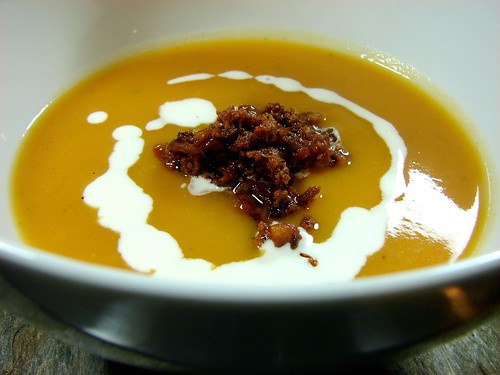
Enjoy! Check out the rest of this meal here.
Cookingly yours,
Anamaris

Well my friends, you know what they say about making plans, right? We make’em and somebody else laughs or something like that. I’m home again; For the good news, I’m happy to report that Panama is actually cooler than Houston is currently. Imagine that. But, the bad news are that my mami’s health continues to deteriorate and so I’ve come to check on her, spend some time with her, ‘boss her around’ as she has told my siblings and I. She also asked me to cook for her as she isn’t a fan of hospital food, and so I have been for the past 3 days.
I will continue to attempt updating posts on the schedule I had committed to, but I am asking for your patience. I’m having to manage preparing foods, spending most of the day with Mami at the hospital, sometimes nights too, such as last night. I will also attempt to incorporate some work in, blogging will have to be squeezed into a nook or cranny some days. On the other hand, being in Panama, I’ll have an excellent repertoire of Latin dishes! YAY!
Today I will share with you a soup Mami made for us growing up, it was her sneaky way of getting us to eat our vegetables. It is a chicken soup base she would cram full of any and all vegetables seasonally available. There was a wide range of goodies: carrots, chayote and acorn squash, potatoes, spinach—you get the picture. This is an easy and quick soup to make, cooking time is very low and the final rewards are wonderful.
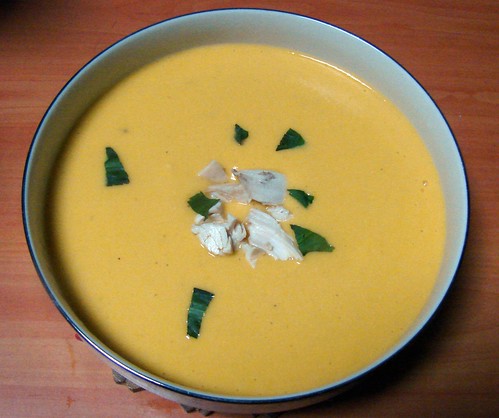
Mami’s Chicken & Veggie Soup (Cream)
Chicken pieces, with bone preferably
1 tbsp vegetable oil
Culantro or cilantro leaves
Chicken bouillon
Vegetables of choice
Sea salt & ground black pepper

Season the chicken pieces with salt & pepper and chop all the vegetables into chunks. Heat a pot over high heat and add the oil. Brown the chicken in batches as necessary. Once all the chicken has been browned, remove the excess fat and add about ½ cp of water to help scrape the drippings off the bottom. Add the cilantro leaf and veggies, then add water to cover.
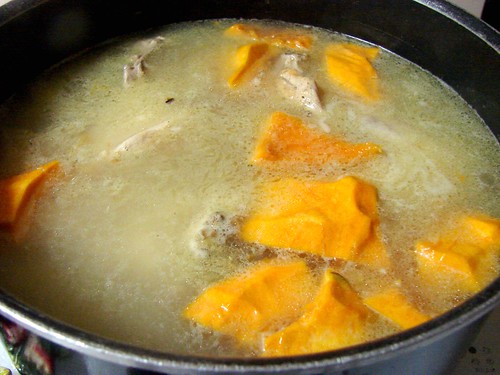
Once it comes to a boil, lower the temperature and allow it to simmer until everything is tender. To ensure we ate all the vegetables, my mami used to puree it all. Remove the chicken meat from the bone, then place the stock, chicken and veggies in the blender or food processor. The beauty of this extra step is that you end up with a thick, flavorful chicken cream without the added calories of heavy cream. My dad, however, doesn’t care for the cream style soups, so he got it straight out of the pot. Serve with white rice.

Cookingly yours,
Anamaris
Because I was under the weather, I had not had an opportunity to finish posting all the recipes for the 24, 24, 24 event I hosted a bit over 2 weeks ago. It was an ambitious menu, to say the least. Every dish was better than the next, I would really have a tough time picking one as my hands down favorite.
This one came representing the New England region and I must admit I was surprised by the use of salt cod. I couldn’t tell you why exactly, because as I think about it, it makes perfect sense. But it still caught me by surprise. The other thing I liked about it was the way the cod was used. As a native Panamanian I’m used to seeing cod in more ‘creole’ presentations. So this was different a change, and one that I enjoyed thoroughly.
I found the recipe on Chow.com. I prepared it as instructed for the night of the event, but we had some of the cod and bean base leftover and I revisited and tweaked the recipe a few days later. So here’s my final rendition of it.
This is a 2-day dish: on day 1 you’ll soak/rehydrate the cod and beans, on day 2 you can put it all together. Plan ahead. *Also, the recipe called for Manila clams which I didn’t find and substituted with Little Necks.
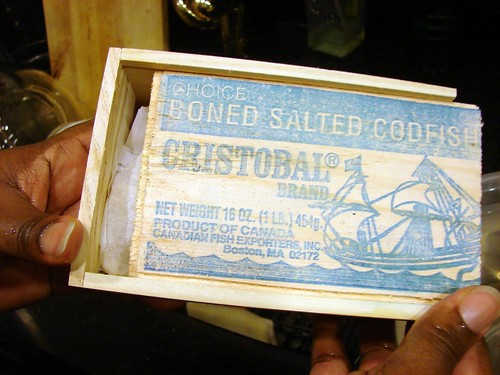
1/2 lb salt cod
2 cps dried white beans (such as Great Northern or cannellini beans)
2 cloves garlic, whole
1 tbsp kosher salt
4 cps whole milk
1 tbsp whole black peppercorns
2 bay leaves
1/3 cp bacon or salt pork, chopped
2 tsp garlic, minced (about 2 cloves)
1/2 cp carrot, diced (about 1 large carrot)
1 1/2 cps leeks, chopped
1 tbsp fresh thyme, chopped
1 lb Manila clams, scrubbed*
1 1/2 cps dry white wine
1/2 tsp lemon zest, grated
3 tbsp Italian parsley, finely chopped
Extra-virgin olive oil, for drizzling
The day before, rinse the salt cod under cool water, then place it in a large glass or plastic mixing bowl with enough cold water to cover and soak overnight in the refrigerator, changing the water 2 or 3 times. Put beans in another bowl, sort and rinse them, then cover them with cold water, and let soak for 24 hours in the refrigerator.

The next day, drain and rinse beans. Transfer them to a medium saucepan and add the whole garlic cloves and fresh cold water to cover. Bring to a simmer and cook gently, being mindful not to boil them. It will take about 40 minutes for them to be cooked through. Once the beans have softened, season them with sea salt & pepper. Remove the garlic cloves and strain the beans but reserve about 1-2 cps of the cooking liquid.
To prep the cod: drain the water it’s been soaking in and transfer to a saucepan. Add milk, peppercorns, and bay leaves and simmer over medium-low heat until fish is soft and flaky, about 20 minutes. Remove from heat, strain fish from the pan, and place in a bowl. Use a fork to flake cod into bite-size pieces. Discard milk and seasonings.
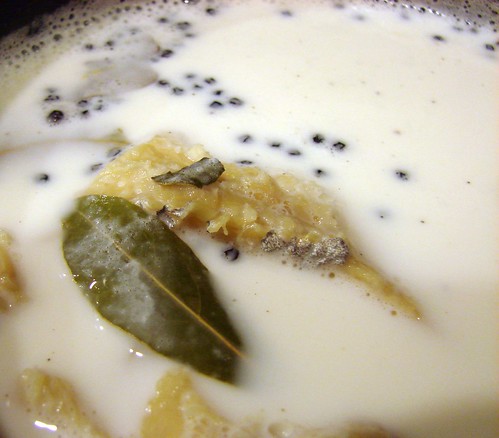
Rinse the saucepan and heat it over medium heat. Add the bacon and cook just long enough to render some of its fat, you don’t want to brown it. Then add the garlic, carrots, leeks, and thyme and cook for 3 minutes, stirring occasionally.
Deglaze the pan with some of the wine, making sure to release all the drippings stuck at the bottom. Add the rest of the wine, cod, veggies and beans and allow it come to a slow boil. Add clams and wine, stir, and cover. Cook just until clams open, about 7 to 10 minutes. (Discard any clams that do not open.)
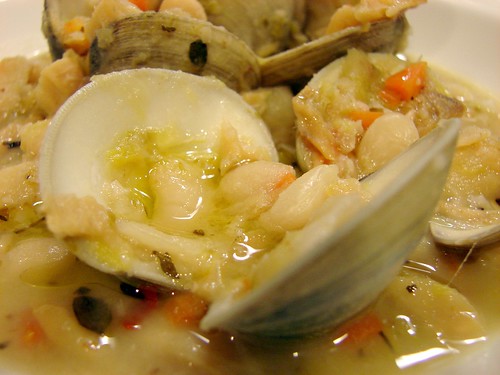
After all the clams have opened, add the lemon zest and parsley and stir; add some of the bean-cooking liquid if the stew seems too thick. Ladle stew into small bowls, drizzle with olive oil, and serve with crusty bread.
I know why crabs are called crabs. It’s because they’re crabby. These are some mean, vicious, unhappy, ugly little creatures. Look at that face, I don’t even think a mother could love it. Maybe that’s the real reason. Years of abandonment by the parental unit and having to live life looking…, well, like that.
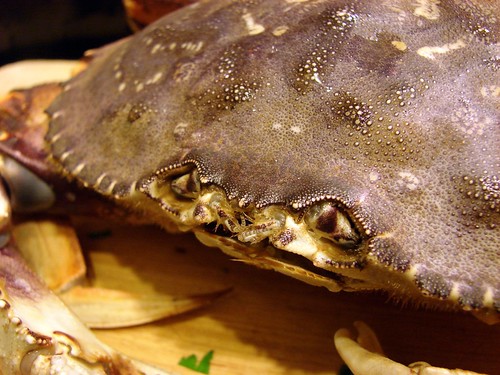
But OH! How I love crab meat! Here’s some lessons learned. Blue crabs are way sweeter than the variety I got when I made my test run a couple of weeks ago. Blue crabs are also smaller, though. So getting the meat out was a SHORE! On the flip, the little blues I got this week, actually had roe in them. I guess next time it will be a call between the ease of the larger crab vs the sweetness and possible roe to be found in the blue ones. Who knows.
What I do know, is that this bisquey-chowdery-creamy soup goodness is out of this world delicious! Aside from making the stock from the live crabs, it was also a breeze. Not that the broth making was difficult, it was the crab meat pulling that proved tedious.
I did learn a little trick for dealing with the live critters. See, I’m not perturbed by their ugly little mugs. I don’t have a problem eating food that looks back at me. I can look ‘em in their beady little eyes and still eat them. But if there had been a candid camera in the kitchen the day I was trying to get these in a pot, it would’ve made for funny footage. Every time one of the little suckers moved, clawed or reared up, I had a similar and equal reaction. Plus I kept picturing them getting on the floor and scurrying around while I tried to catch them. That’s why this tip is so awesome.
If you put them in the freezer for a few minutes-30 or so, they go into a little slumber that gives you enough time to clean’em up and pot them. All I did was leave them in the bag they came, shove it in the freezer and ignored them for a while.
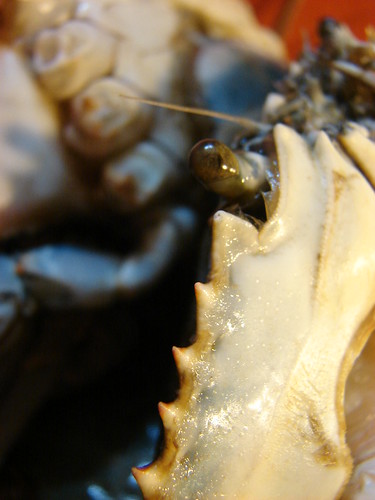
While the crabbies chill out, pun intended, get started on the stock. Any veggies you have laying around will do. I had onions, garlic, celery, carrots, the tops of some leek bunches. No need to get fancy with any of these, a quick rinse and rough chop is good enough. I even left the skins on the onions, garlic and carrots.
Just put the whole thing in a stockpan, add enough water to cover the crabs once you put them in (about 12 cups or so). Add a couple of bay leaves and if you have whole peppercorns, throw about 1 tbsp of those in. I put them on the cutting board and squashed them with the handle of a heavy knife, just enough to break them a bit. Add 2 tbsp of sea salt, cover the pan and bring it all to a boil for about 5-10 minutes. While this is happening, get back to your crabs.

Once you’ve gotten the crabs good and drowsy, it’s easy to remove the big front claws. You want those off before they wake up again or you may end up missing a finger. With the claws removed, you can now give them a little scrub to get any debris off. Don’t forget these are bottom-feeders.
After cleaning them, remove the little plate that protects their underbody. Don’t dispose of it, though, any and all shell matter will enhance the stock you’re about to make.
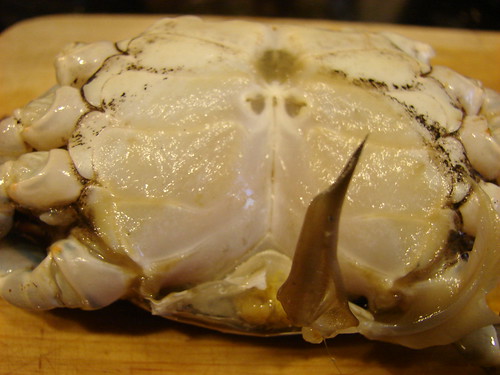
Next, take a knife and break straight through the crab. Essentially, cut the sucker in half. When you remove any pieces from the crab, there will be a bit of liquid that comes out, make sure you’re breaking the crab over a bowl and do the best you can to hold on to that liquid. I can’t be sure, but I would think it is similar to the juice you find when you open an oyster.

In any case, place the crab pieces into a bowl until you’re ready to throw them into the stock. Break apart the little legs too, there’s hardly any meat in them and you can leave those in the stock while you shell the meaty parts.
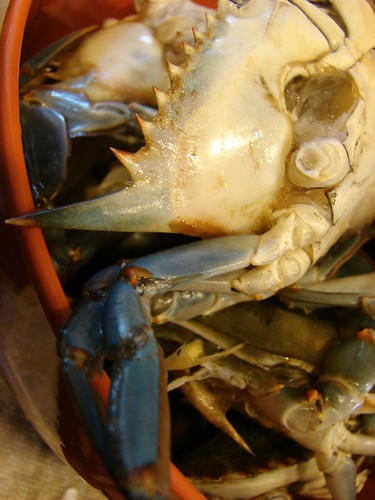
With the crab cleaned, you’re ready to cook them. While the stock is still boiling, drop all the crab pieces in and allow them to cook for about 10-12 minutes. After that time, you’ll want to remove the pieces that hold meat and shell them.
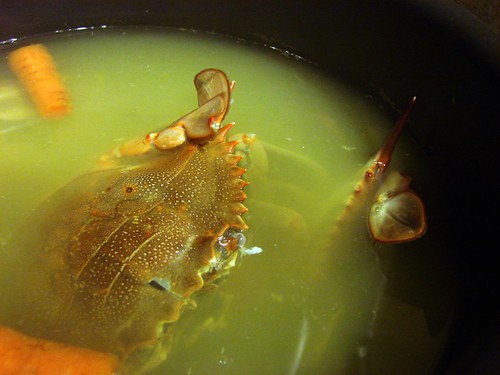
The shells will turn a pretty shade of orange. Lower the temperature on the stock, you now want it to simmer. As I mentioned, any portions that do not hold meat can stay in the pot. Allow the meaty pieces to cool before you begin handling them. As you remove the meat from the shells, throw the empty shells back into the stockpot.
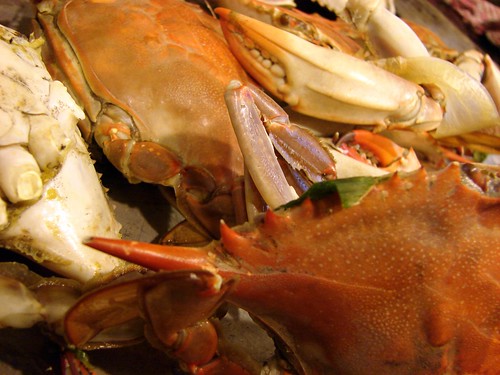
Allow the shells to cook in the stock for about an hour or so. Then turn off the heat and let it cool. Remove all the large bits out of the stock and strain it through a fine sieve. Set the stock aside. Next, we’re starting the soup.
As luck would have it, I didn’t have an actual working recipe, I found a ‘how to make it’ blurb that sounded as authentic as this soup can get and I went with that. I will share a ‘this & that’ recipe with you since I made it twice. I can tell you that it’s not one of those dishes you can mess up. Once you have the stock, it’s easy-breezy.
Back in the day, this soup was made with female crabs and their roe was harvested and added to the broth. You may have a difficult time finding crabs with roe, as crabbers are required to toss them back in the water. The little blue crabs I purchased for the second soup, had tiny bits of roe inside. Yep, I kept it and added it to the soup; I didn’t have any the first time and I couldn’t tell a difference in the taste. What I’m trying to say is, roe isn’t a deal breaker.
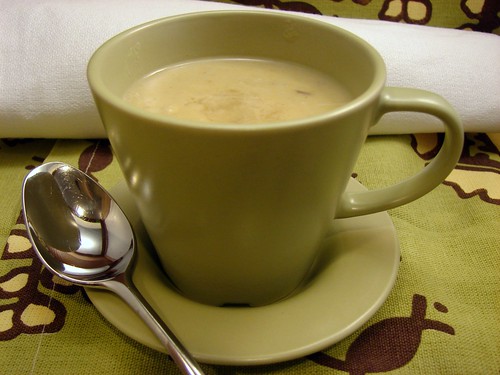
She Crab Soup
To make about 12 cups of soup:
2 tbsp extra virgin oil
1 large onion, chopped
3-4 garlic cloves, chopped
2 celery stalks, chopped
2 bay leaves
2 cps whole milk
1 cp sherry, plus more to serve
10 cps crab stock
1 cp long grain rice
1 tsp Worcestershire sauce
Sea salt & black pepper
1/4-1/2 tsp mace
1/2 cp heavy cream
About 3 cps crab meat (whatever you pulled from the live crabs, plus 1 store-bought container–approx 8 oz)
In a medium sized pan, heat the oil before adding the onions, garlic and celery, cook them until they are clear. Add 1 cp of sherry to deglaze any drippings that may be stuck to the bottom of the pan. If you found any crab roe, add it now together with the bay leaf, rice and stock. After it begins to boil, add the milk and lower temperature to a slow simmer. It will need to cook for about 30 minutes for the rice to soften. Make sure you stir it every once in a while.

Once the rice has cooked and exploded, remove the bay leaves and ladle this broth into the glass of your blender and puree it. This part can be made ahead of time and refrigerated until you’re ready to serve it. The rice thickens this soup nicely and makes it unnecessary to add lots of cream.
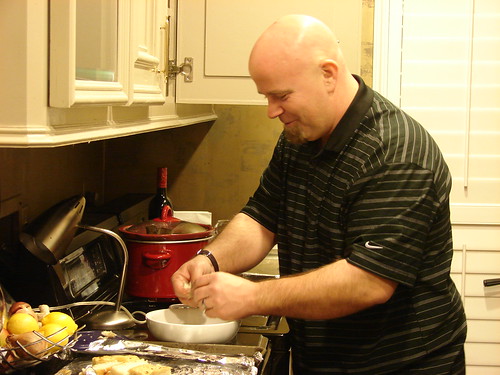
That's hubby making sure there are no shells in the crab meat
Just before serving, heat the blended broth, add the cream, Worcestershire and mace. You can add some hot sauce or cayenne pepper, if you’d like. Finally, add the crab meat and season with salt and pepper, if needed.
To serve, add about 1 tsp of sherry to the bottom of the bowl before ladling the soup. This soup saves quite well in the freezer.

Enjoy!
Cookingly yours,
Anamaris






















































